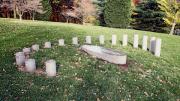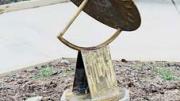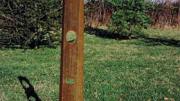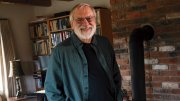On the front lawn of the U.S. vice-presidential residence in Washington, D.C., less than 150 yards from the nation’s most precise clock, sits another type of timepiece. Its measurements are approximate, its hour hands are absent, its polished granite time markers are useless when the sky is overcast. It can’t tick off nanoseconds like the atomic Master Clock at the neighboring U.S. Naval Observatory; the sundial’s hour hand appears only as a shadow cast toward the crescent of red granite markers 10 feet from its central stone.
But for designer Michael R. Kapetan ’69, a sculptor and teacher at the University of Michigan School of Art and Design, keeping exact time has little to do with his art. “We are all too caught up in clock time,” he says from his converted one-car-garage studio in Ann Arbor, Michigan. “I coined the term ‘solar sculpture’ to get away from the traditional garden artifacts that mark the hours, and get to a broader idea of art that addresses the sun, the seasons, and time.”
Hewn in stone, steel, and concrete, Kapetan’s solar sculptures are original artistic visions, he says, “arranged according to the laws of nature.” Carefully aligned by solar observations to the rotational axis of the earth, or “true north,” and precisely calibrated for latitude (the vice-presidential sundial’s alignment was confirmed by a naval officer and an astronomer brought in by Kapetan), his creations keep accurate solar time by measuring, in shadows, the apparent motion of the sun. (With no adjustments for longitude, however, his dials can depart from standard 24-hour clock time by an hour on a daily basis, or as many as two during daylight savings time, depending on the sculptures’ locations.)
His solar structures have twice taken the form of unconventional giant sundials like the vice president’s, where a person standing on the flat central stone, not the work itself, becomes the “gnomon,” or shadow caster. But Kapetan has also explored other timepiece formats. For more than two decades, at an elementary school in Michigan, students have gathered around his nearly seven-foot-tall, stainless-steel, I-beam-like sculpture on the solstices and equinoxes to witness the fleeting moment when a ray of sunlight shines through one of its three elliptical apertures and appears on the appropriate ground target as a bright white disk.
Kapetan’s sundial fascination began, he says, with a television special he watched as a teenager about the prehistoric site Stonehenge, in England. “It wasn’t a sculpture, temple, or observatory, yet it was a strange combination of all three,” he explains, still reverent as he describes the early timepiece decades later. “I am struck by the beauty of scientific instruments, and preoccupied with the connections among science, art, and spirituality.”
The son of a precision grinder in the aerospace industry, Kapetan grew up tinkering in his dad’s workshop in Wayne, Michigan, and after earning an art history degree from Harvard and an M.F.A. from the University of Michigan in 1978, he pursued a career creating both abstract and liturgical sculpture. Although his solar timepieces are among his most impressive works, his commissions for them are sparse in comparison to his liturgical carvings. To date, he’s completed four sundials in two states, with a fifth and sixth in progress; his wood and stone liturgical work—a 10-foot-wide tree of life carved in relief on a synagogue wall, a child’s-height chiseled sculpture of Saint Thomas à Becket in a Catholic church, two nine-foot-wide altar doors adorned with sheaves of wheat and life-size doves in an Eastern Orthodox sanctuary—are among 40 commissions displayed in 34 churches and synagogues across the country, including the National Cathedral in Washington, D.C.
In 1994, Kapetan spent a year as the cathedral’s artist in residence and, as luck would have it, he worked around the corner from the vice-presidential residence, then occupied by his former college roommate, Albert Gore Jr. ’69, LL.D. ’94. On a visit to the residence, Kapetan and the Gores discussed the idea of a front-lawn sundial; three years later Kapetan installed the work.
“Without a person in it, the [vice-presidential] sundial reverts to being an alluring concatenation of form—an intrinsically beautiful arrangement that can hold its own alongside any man-made object,” Kapetan says, describing the sculpture’s arc of hour markers. “However, when one steps into its embrace, it comes alive like no other kind of sculpture and tells you not only where, but when, you stand.”











